The fibrinolytic system in dissemination and matrix protein deposition during a mycobacterium infection
- PMID: 12875972
- PMCID: PMC1868210
- DOI: 10.1016/S0002-9440(10)63680-2
The fibrinolytic system in dissemination and matrix protein deposition during a mycobacterium infection
Abstract
The fibrinolytic system is known to play an important role in the inflammatory response to bacterial infections. In the present study, relationships between protein components of the fibrinolytic system and infectivity by Mycobacterium avium were analyzed. Infections were initiated through noninvasive intratracheal administration of M. avium 724 in mice individually deficient for plasminogen, tissue-type plasminogen activator, urokinase-type plasminogen activator, and urokinase-type plasminogen activator receptor, along with wild-type control mice. There were no differences in lung colony counts among all mouse genotypes throughout a 10-week infection. However, in tissue-type plasminogen activator and plasminogen-deficient mice an earlier dissemination of M. avium to other organs was observed. Nevertheless, the M. avium growth rates in the liver, spleen, and lung did not differ between the various mouse populations throughout a 10-week infection. Histochemical and immunohistochemical analyses at 5 and 10 weeks after infection demonstrated that plasminogen-deficient mice, compared to wild-type mice, had enhanced fibrin and fibronectin deposition, as well as increased neutrophil infiltration within liver granulomas. These results suggest that plasmin(ogen) plays a role in the turnover of extracellular matrix proteins within granulomas and has a limited effect in the early dissemination of M. avium from lungs. Thus, plasmin(ogen) functions in limiting progressive fibrosis in the granuloma during a chronic mycobacterial infection.
Figures
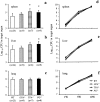


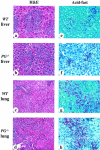


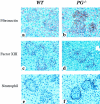
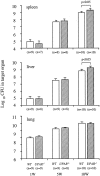
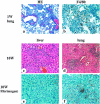

Similar articles
-
The development of bleomycin-induced pulmonary fibrosis in mice deficient for components of the fibrinolytic system.Am J Pathol. 2000 Jul;157(1):177-87. doi: 10.1016/S0002-9440(10)64529-4. Am J Pathol. 2000. PMID: 10880388 Free PMC article.
-
The response of the fibrinolytic system to mycobacteria infection.Tuberculosis (Edinb). 2012 Nov;92(6):497-504. doi: 10.1016/j.tube.2012.07.002. Epub 2012 Aug 11. Tuberculosis (Edinb). 2012. PMID: 22885283
-
Coordinated induction of plasminogen activator inhibitor-1 (PAI-1) and inhibition of plasminogen activator gene expression by hypoxia promotes pulmonary vascular fibrin deposition.J Clin Invest. 1998 Sep 1;102(5):919-28. doi: 10.1172/JCI307. J Clin Invest. 1998. PMID: 9727060 Free PMC article.
-
The role of the pericellular fibrinolytic system in angiogenesis.Jpn J Physiol. 1997 Apr;47(2):161-71. doi: 10.2170/jjphysiol.47.161. Jpn J Physiol. 1997. PMID: 9201545 Review. No abstract available.
-
Coagulation, fibrinolysis, and fibrin deposition in acute lung injury.Crit Care Med. 2003 Apr;31(4 Suppl):S213-20. doi: 10.1097/01.CCM.0000057846.21303.AB. Crit Care Med. 2003. PMID: 12682443 Review.
Cited by
-
Plasmin and plasminogen prevent sepsis severity by reducing neutrophil extracellular traps and systemic inflammation.JCI Insight. 2023 Apr 24;8(8):e166044. doi: 10.1172/jci.insight.166044. JCI Insight. 2023. PMID: 36917195 Free PMC article.
-
Elucidating novel serum biomarkers associated with pulmonary tuberculosis treatment.PLoS One. 2013 Apr 18;8(4):e61002. doi: 10.1371/journal.pone.0061002. Print 2013. PLoS One. 2013. PMID: 23637781 Free PMC article.
-
Infectious disease, the innate immune response, and fibrosis.J Clin Invest. 2007 Mar;117(3):530-8. doi: 10.1172/JCI30595. J Clin Invest. 2007. PMID: 17332880 Free PMC article. Review.
-
Expression and arrangement of extracellular matrix proteins in the lungs of mice infected with Paracoccidioides brasiliensis conidia.Int J Exp Pathol. 2008 Apr;89(2):106-16. doi: 10.1111/j.1365-2613.2008.00573.x. Int J Exp Pathol. 2008. PMID: 18336528 Free PMC article.
-
The effect of intravesical instillation of antifibrinolytic agents on bacillus Calmette-Guerin treatment of superficial bladder cancer: A pilot study.Indian J Urol. 2008 Jul;24(3):426-7. Indian J Urol. 2008. PMID: 19468486 Free PMC article. No abstract available.
References
-
- Saunders BM, Cooper AM: Restraining mycobacteria: role of granulomas in mycobacterial infections. Immunol Cell Biol 2000, 78:334-341 - PubMed
-
- Ehlers S: Immunity to tuberculosis: a delicate balance between protection and pathology. FEMS Immunol Med Microbiol 1999, 23:49-58 - PubMed
-
- Castellino FJ, Ploplis VA: Plasminogen and streptokinase Bachmann F eds. Handbook of Experimental Pharmacology, Fibrinolytics and Antifibrinolytics 2000, vol 146:pp 25-56 Springer-Verlag, New York
-
- Lijnen HR: Plasmin and matrix metalloproteinases in vascular remodeling. Thromb Haemost 2001, 86:324-333 - PubMed
Publication types
MeSH terms
Substances
Grants and funding
LinkOut - more resources
Full Text Sources
Other Literature Sources
Molecular Biology Databases

